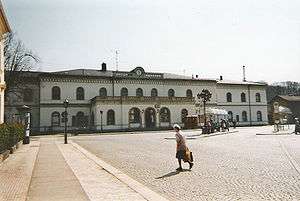Crimmitschau
| Crimmitschau | ||
|---|---|---|
|
Mannichswalde, which is part of Crimmitschau | ||
| ||
 Crimmitschau Location of Crimmitschau within Zwickau district   | ||
| Coordinates: 50°49′5″N 12°23′15″E / 50.81806°N 12.38750°ECoordinates: 50°49′5″N 12°23′15″E / 50.81806°N 12.38750°E | ||
| Country | Germany | |
| State | Saxony | |
| District | Zwickau | |
| Government | ||
| • Mayor | Holm Günther | |
| Area | ||
| • Total | 61.04 km2 (23.57 sq mi) | |
| Elevation | 273 m (896 ft) | |
| Population (2017-12-31)[1] | ||
| • Total | 18,746 | |
| • Density | 310/km2 (800/sq mi) | |
| Time zone | CET/CEST (UTC+1/+2) | |
| Postal codes | 08451 | |
| Dialling codes | 03762 | |
| Vehicle registration | Z | |
| Website | www.crimmitschau.de | |
Crimmitschau (German pronunciation: [ˈkʁɪmɪtʃaʊ]) is a town in the district of Zwickau in the Free State of Saxony.
Geography
Crimmitschau lies on the River Pleiße in the northern foothills of the Erzgebirge.
Neighboring municipalities
Adjacent communities include: Zwickau, Dennheritz, Neukirchen, Meerane, and Langenbernsdorf in Landkreis of Zwickau; Heyersdorf, Jonaswalde, Ponitz and Thonhausen in Thuringian Landkreis of Altenburger Land; as well as Braunichswalde, Rückersdorf, and Seelingstädt in Thuringia in Landkreis of Greiz.
Municipality subdivisions
Crimmitschau's subdivisions are Rudelswalde, Lauenhain, Langenreinsdorf, Mannichswalde, Frankenhausen, Wahlen, Gösau, Gosel, Gablenz, Blankenhain, Großpillingsdorf, and Harthau.
History
In the course of German eastward expansion, the city of Crimmitschau and a castle of the same name (now called the Schweinsburg) were established from around 1170 to 1200 as an organized German colony. The settlement's existence is first documented in 1212. In 1414 Crimmitschau received town privileges from Markgraf Wilhelm II.
On 15 March 1844, Crimmitschau was connected to the German rail network (on the Leipzig–Hof railway, which was later extended to Bavaria). Its current station was opened in 1873
Around the turn of the century, Crimmitschau was the site of a large concentrated textile industry, and was called "The City of 100 chimneys" (Stadt der 100 Schornsteine).
From August 22, 1903 to January 18, 1904, it was the site of one of the largest and longest strikes in the German Empire, which affected the entire nation.
In 1944, some Crimmitschau property was bombed by Allied Forces.
At the end of the 1980s, a great part of the old and inner cities were torn down and replaced with prefabricated concrete buildings. Similar plans existed for the southern suburb, but were not put in place after the regime change in 1990.
Population

|
|
Religion
Even though almost 50 percent of the people in the Crimmitschau area are Atheists, there are some Protestant parishes and even a Catholic parish, belonging to the Diocese of Dresden-Meissen. The most important churches are: St. Laurentius-Kirche, Johanniskirche, and the Lutherkirche.
International relations
Crimmitschau is twinned with:
Museums
- Western Saxon Textile Museum, which is located in a fully functional textile factory, former known as "Gebrüder Pfau KG"
- The Agricultural and Open-Air Museum of Schloss Blankenhain
Buildings
Landmarks include the town hall, the late gothic parish church of Saint Larentus (1513), with its star and cross ribbed arches, a former Cistercian Convent (founded around 1290) in the district of Frankenhausen and the open-air museum of Blankenhain Castle located at the castle of the same name.
Music
- Helmut Bräutigam, composer
Parks
- The Zöffelpark, which was built in the pre-war period and named after Emil Oskar Zöffel, an important textile manufacturer and Philanthropist in the history of the city.
- The Bismarck-Hain, a former cemetery, named after Reichskanzler Otto von Bismarck. This park was known as Friedenspark (Peace-park) during GDR-times.
- The Sahnpark, located north of the city center, is the largest park in Crimmitschau and harbours an old open-air bath, an animal park and the stadium of ETC Crimmitschau.
Sports
Crimmitschau has a well-known ice hockey club, the ETC Crimmitschau, which plays in the second highest German league. The city also has a soccer team, FC Crimmitschau and an American Football Team, the Tornados Crimmitschau.
Business and Infrastructure
Crimmitschau lies directly at the Autobahn A4 and can be reached through the exits Schmölln and Meerane. The Deutsche Bahn AG provides connections from Crimmitschau station to Zwickau, Leipzig, Hof.
Education
There are 3 elementary schools (Grundschule), two secondary schools (Mittelschule), a high school (Gymnasium), and a special education school (Förderschule) in Crimmitschau:
- Käthe-Kollwitz-Grundschule
- Grundschule Frankenhausen
- Grundschule Blankenhain
- Käthe-Kollwitz-Mittelschule
- Mittelschule Sahnschule
- Julius-Motteler-Gymnasium
- Förderschule Lindenschule
Notable Residents
- 1838 - Julius Motteler (died 1907), Reichstag deputy, co-founder of the Social Democratic Party of Germany
- 1840 - Adolf Paul Schulze (1840-1891) emigrated to Scotland and became a successful merchant and noted microscopist
- 1909 - Heinrich Mauersberger, (died 1982 in Bestensee), engineer and inventor in the textile industry.
- 1925 - Gerhard Zwerenz (died 2015), writer and former Bundestag deputy
- 1937 - Peter Graf, painter
- 1942 - Wolf-Dieter Storl, ethnobotanist, author
- 1954 - Klaus Gruner, handball player, Olympic champion 1980
- 1955 - Udo Kießling, ice hockey player
- 1957 - Andreas Schmidt, novel author
- 1961 - Gabi Zange, speed skater
Honorary citizen
- 1895: Otto von Bismarck, chancellor of the Reich
- October 12, 1984: Walter Richter, gardener
See also

References
- The information in this article is based on and/or translated from its German equivalent.
- Notes
- ↑ "Aktuelle Einwohnerzahlen nach Gemeinden 2017] (Einwohnerzahlen auf Grundlage des Zensus 2011)" (PDF). Statistisches Landesamt des Freistaates Sachsen (in German). October 2018.
External links
- Coat of Arms
- (in German) ETC-Crimmitschau
- (in German) the West Saxon Textile Museum of Crimmitschau
- (in German) Agricultural and Open-Air Museum of Schloss Blankenhain
- (in German) the Julius-Motteler-Gymnasium of Crimmitschau

.jpg)
